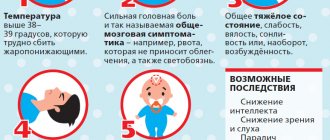- Home >
- Clinic services >
- Neurology >
- Cerebral vasospasm
In the human body, the brain is the most important organ, which not only regulates the functioning of all other organs and systems, but is also responsible for our consciousness, perception and memory.
The human brain, like any other organ, must be supplied with blood and receive the required amount of oxygen and metabolic substances. Therefore, the microvasculature of the brain is one of the most complex vascular networks in our body. Indeed, when blood flow to the brain is disrupted, pathological processes occur, many of which are irreversible. One of the common causes of circulatory disorders in various parts of the brain is vascular spasm. Nowadays, cerebral vasospasm is a condition that most often occurs in people over 30 years of age. What is a spasm, how and why does it occur in the vessels of the brain, and how should this condition be treated?
The definition is: a spasm is a case of sudden contraction of smooth or striated muscle. It is known that our vessels have a wall consisting of smooth muscle, when a vessel spasm (angiospasm) occurs, the lumen of the vessel closes, which is always fraught with complications.
General information
Vascular spasm (syn. angiospasm) is a pathological transient narrowing of the lumen of large/small arteries and capillaries due to prolonged intense/excessive contraction of the muscles of the vascular wall, causing disturbances in blood circulation/tissue metabolism.
Angiospasm can be considered as a variant of vascular crisis (acute vascular dystonia). Normally, due to their elasticity, blood vessels ensure uninterrupted and adequate blood flow to various organs, which ensures their functioning. With vascular spasm of varying degrees/localization, the parameters of local/systemic hemodynamics are correspondingly disrupted.
Maintaining vascular tone is carried out due to the tension of the vascular muscle layer, and the contractile activity of the muscle layer is directly regulated by nerve impulses from the brain arriving through sympathetic nerve fibers. It is the myogenic reactions of blood vessels that support circulatory homeostasis . In addition to muscle regulation of tone, its maintenance is carried out due to metabolic, humoral-hormonal and neurogenic mechanisms of vascular regulation.
Developing arterial insufficiency due to spasm of the arterial network leads to tissue ischemia in the area of the spasmodic artery and the development of hypoxia of various organs and tissues, which is manifested by disturbances in their functions. Previously, vasospasm was classified as a disease of “old age,” but currently there is a clear trend towards rejuvenation of vascular disorders. The reason is the high pace of life with frequent stress and unfavorable environmental conditions. The consequence of vasospasm is ischemia .
Angiospasms can occur in different vascular regions, mainly in diseases characterized by damage to the arteries/nervous apparatus ( aneurysms , atherosclerosis , vasculitis , etc.) or disorders of the neurohumoral regulation of vascular tone ( neuroses , hypertension , pathological menopause , hypothalamic syndrome , etc. .). Angiospasm often shapes the dynamics of clinical symptoms in organic vascular diseases, such as thrombosis , atherosclerosis , embolism, etc.), significantly complicating their course. Prolonged chronic or acute arterial insufficiency in the heart (coronary vasospasm), brain (cerebral vasospasm), and in the retina (retinal vasospasm) can cause the development of acute vascular insufficiency. As a rule, acute arterial obstruction is the cause of such serious conditions as myocardial infarction , stroke , and visual impairment.
Vascular stenosis develops in most cases with atherosclerotic damage to the arteries, which is caused by the deposition of cholesterol plaques on the walls. Chronic arterial insufficiency of the lower extremities is also widespread. What are the types of vascular diseases in the legs? In the lower extremities, so-called “occlusive vascular diseases” are quite common, provoked by narrowing/clogging of the iliac arteries/abdominal aorta as a result of the deposition of atherosclerotic plaques on their walls, which significantly impairs the blood flow of the lower extremities. These are obliterating diseases of the peripheral arteries of the legs ( atherosclerosis obliterans , thromboangiitis obliterans , endarteritis obliterans , diabetic angiopathy ), characterized by a steadily progressive course with the transition of increasing intermittent claudication to a constant pain syndrome. Critical leg ischemia leading to gangrene is an extremely severe outcome of long-term arterial insufficiency.
When should you stop taking medications?
Many people on vacation, feeling well, forget or stop taking medications that lower blood pressure. This cannot be done. It is necessary to be treated not when the pressure rises, but so that it does not rise. Therefore, taking medications is constant. Despite the huge variety of brands and names of drugs in pharmacies, there are only five classes of drugs that are recommended for the treatment of arterial hypertension. They can be varied and combined. But the main thing is not the choice of drug, but the achievement of “target pressure”. According to modern recommendations, ideally it should be 120 to 80 mmHg for everyone. Art. Even for older people. And only in certain situations, when it is poorly tolerated, for example, if the same vessels of the neck are damaged, the upper pressure can be 130 and even 134–135.
Link to publication: aif.ru
Pathogenesis
The pathogenesis of vasospasm has not yet been fully studied, which is largely due to its non-identity for arteries of different vascular regions. It is generally accepted that a common factor in the mechanism of development of vasospasm includes functional disorders of the membranes of smooth muscle cells of the vessel, the essence of which is a violation of the exchange of potassium, calcium, and sodium ions through the membranes, which disrupts the alternation of muscle contraction/relaxation phases. Enhanced/accelerated depolarization of membranes, as well as an increased influx of free calcium ions into cells, contribute to intense muscle contraction, and a delay in membrane repolarization (preceding muscle relaxation) contributes to prolonged contraction of the arterial wall.
Disturbances of this kind may be caused by disturbances in the innervation of vascular walls, an imbalance in the production/destruction of humoral regulators of tone, increased sensitivity of vascular wall receptors to the effects of vasoconstrictors, and a disorder of humoral regulators of vascular tone. Often, stenosis can develop against the background of local changes in the vessel wall in areas of thrombus , vascular inflammation, scars (for example, near the area of coronary artery thrombosis/location of an aneurysm or atherosclerotic plaque).
Causes
The causes of vascular spasms have not been sufficiently studied, however, a number of diseases can be identified that are accompanied by vasospasm in different vascular regions:
- Atherosclerosis at the stage of pronounced atherosclerotic changes in the vascular bed.
- Osteochondrosis of the spine in the cervical region.
- Hormonal disorders in diseases of the endocrine system ( diabetes mellitus ).
- Diseases of the cardiovascular system ( hypertension , atrial fibrillation ).
- Dysfunction of the autonomic nervous system.
- Traumatic brain injuries.
- Frostbite.
- Stress and overwork.
- Brain hemorrhages.
- Vasculitis is inflammation of the artery (vascular walls).
- Brain tumors.
- Chronic intoxication (poisoning with lead/carbon disulfide compounds).
The most common/significant risk factors for the development of vasospasm are: arterial hypertension , smoking, alcohol abuse, male gender, old age, dyslipidemia , physical inactivity and excess body weight. Among them, the greatest importance is given to disorders of fat metabolism and arterial hypertension.
Obviously, the causes of vasospasm in different vascular regions differ, that is, the causes of spasms of cerebral vessels and the causes of vasospasm of the retina or lower extremities are different.
Symptoms
Symptoms of vascular spasm are determined by its localization and are manifested by manifestations of dysfunction of ischemic tissue of various organs. Let's look at just a few of them:
Symptoms of vascular disease in the legs (using the example of obliterating atherosclerosis ). Depending on the severity of insufficiency of arterial blood supply to the limb, several stages of clinical manifestations of the disease are distinguished:
- Stage of functional compensation . At this stage, cramps, chilliness and paresthesia of the lower extremities are characteristic, and less often - burning/tingling in the fingertips, leg fatigue, and increased fatigue. As the skin cools, it becomes pale and cold to the touch. As a rule, when walking on level ground after 1000 meters or more, intermittent claudication appears due to insufficient blood supply to the muscles, accumulation of under-oxidized metabolic products in tissues and disruption of the process of oxygen utilization.
- Subcompensation stage . There is an increase in the intensity of intermittent claudication, which already occurs after traveling a distance of about 200 m. The skin of the legs/feet becomes dry, loses elasticity and flakes, and hyperkeratosis . Characterized by a slowdown in hair growth (patches of baldness appear) and nails, which become dull, brittle, thickened and acquire a matte color. Initial signs of atrophy of the foot muscles and subcutaneous fat are noted.
- Stage of decompensation . Against the background of ongoing spasm of the vessels of the legs of the affected limb, pain appears at rest, and walking is possible at a distance not exceeding 25 meters. Progressive atrophy of the leg/foot muscles is noted, the color of the skin of the legs changes, and the skin turns pale when the limb is raised and redness appears when it is lowered. The skin becomes easily vulnerable and various types of minor injuries (abrasions/ bruises ) lead to the formation of non-healing chronic wounds , cracks , and painful superficial ulcers . The patient has limited ability to work. With severe pain syndrome, disturbances in night sleep are observed, patients take a forced position - the “doll” pose.
- Stage of destructive changes . At this stage, vasospasm of the lower extremities causes the development of necrobiotic processes. And the rate of their increase is determined by the level of the gap between the amount of blood flow to the tissues and their need for oxygen. The pain in the fingers and feet is extremely intense. The resulting ulcers are located mainly in the distal parts of the legs (usually on the fingers). The bottom/edges of the ulcers are covered with a gray-dirty coating without granulation, and there is inflammatory infiltration around them. Swelling of the foot/leg develops. Characteristic is the development of wet gangrene of the fingers and feet. The ability to work at this stage is completely lost.
Symptoms of cerebral vascular spasms
Angiospasm of cerebral vessels, contributing to the development of chronic circulatory failure of brain structures (dyscirculatory encephalopathy) can develop with damage to the main arteries (stenosis of the vertebral/carotid arteries), narrowing/thickening of intracerebral arteries against the background of arterial hypertension and due to narrowing of the lumen due to thickening of the walls of small arteries.
There are several stages of development of dyscirculatory encephalopathy. The initial symptoms of the disease may be latent for some time. At this stage, the disease manifests itself with complaints of noise in the head, headaches , dizziness , and decreased non-professional memory and performance. Patients may be tearful, distracted, irritable, and depressed. They experience difficulty transitioning from one type of activity to another.
At the next stage, non-professional/professional memory impairments progress, a narrowing of the range of interests, a decrease in intelligence, and fixation on a specific problem are noted. The patients are quarrelsome, and personality changes are increasing. Such patients sleep poorly at night and are drowsy during the day. Neurological symptoms increase, spasms in the head are noted, movements slow down and their coordination is impaired, staggering when walking/mild speech impairment is characteristic, and performance is significantly reduced.
Subsequently, against the background of ischemia, gross changes in the tissue of certain brain structures occur, which intensifies the manifestations of neurological symptoms, and mental disorders develop. Patients stop recognizing loved ones, can get lost while walking, perform inappropriate actions and almost completely lose their ability to work.
Angiospasm of the retina
Bilateral retinal vasospasm is typical, less often a unilateral process is noted. Patients complain of the appearance of “fog” before the eyes and the flickering of “floaters”. With a short-term spasm, blurred vision is possible, but it is transient. Distortion of visual perception in the form of meta/photomorphopsia is possible. In some cases, a feeling of discomfort appears in the orbital area; patients may feel pulsation in the temples, headache and dizziness . After the attack is over, the patient’s condition returns to normal and visual function is restored. In severe cases (acute obstruction of the central retinal artery) can lead to a pronounced/irreversible decrease in visual acuity.
From hot to cool
A comfortable temperature is considered to be 18–24 degrees outdoors or indoors. But these numbers are approximate. The temperature to which a person is accustomed is comfortable. A resident of Siberia feels best at 23-24°C and does not tolerate 40-degree heat well. If a person lives in the south, then in a cool climate it will not be healthy for him either. At the same time, the main influence on the body is not the air temperature itself, but a complex of weather conditions: in addition to temperature, it is humidity, atmospheric pressure, magnetic field, wind. So, in a dry climate you can feel great at +32-34°C. And in the humid weather and +27 for many it is a test.
Today there are air conditioners everywhere, and they are used incorrectly. There is an unshakable rule: the air conditioner temperature should be a maximum of 5–7° less than outside. Let’s say, if it’s +34 outside, then the air conditioner should be set not at +18, but at +27. This will be enough to feel cool without getting a cold or sciatica.
Tests and diagnostics
The diagnosis of “angiospasm” is based on the presence of characteristic symptoms of vasospasm and their dynamics, characteristic of the development of transient ischemia in the area of the spasmodic artery. To establish a diagnosis, the following is carried out:
- Ultrasound of leg vessels (Doppler/duplex scanning).
- CT angiography (with contrast agent) of cerebral vessels, which allows you to clearly determine the diameter of the lumen of the vessels and visualize the places of narrowing.
- Dopplerography of cerebral vessels (to assess the speed of blood flow in the intracranial arteries in various areas).
- MRI of the brain/cervical spine.
- Doppler ultrasound of the brachiocephalic arteries.
- Fundus ophthalmoscopy.
- Functional tests (Goldflam/thermometric, etc.).
Laboratory methods include biochemical blood tests, determination of blood cholesterol levels, and coagulogram. In the presence of cognitive impairment - neuropsychological testing.
Massotherapy
This method of pain management is used as a preventive measure for the development of pathology; it is carried out for fifteen days in a row. Each point of influence (moderate pressure) together with massage should be carried out for three minutes, seven times a day. It is recommended to close your eyes during the procedure.
It is necessary to carry out a light circular massage for three minutes with a gradual increase in the strength and depth of pressure in the area of the tubercle of the frontal bone, which vertically divides the face in half. The second point is on the hairline, located vertically above the first point. Further along the vertical line you need to get to the top of the head and, mentally dividing the head into four parts, find a point in the center in the crown area. This will be the third point. More points are located on the bridge of the nose, in the area of the eyebrow break, in the area of the first cervical vertebra.
Prevention
Prevention of vascular diseases, including vasospasm, consists of maintaining a healthy lifestyle, including:
- Balanced diet.
- Active lifestyle.
- Stop smoking.
- Body weight control.
- Monitoring blood pressure , cholesterol /sugar levels.
- Periodic medical examinations.
The basis for the prevention of thrombosis and vascular diseases is the strengthening of blood vessels, which is achieved by regular practice of procedures such as contrast showers/douches, contrast foot baths, bath procedures, lymphatic drainage massage, pine/turpentine baths.
Alternative medicine
Many traditional medicines help normalize blood circulation and vascular tone, but they are recommended to be taken regularly.
The most popular remedy for strengthening blood vessels is garlic. It needs to be crushed and filled with vegetable oil (one head of garlic per two hundred grams of oil). The mixture is left for one day, after which one teaspoon of lemon juice is added. This remedy is recommended to be taken one spoon in the morning, the course of treatment is three months.
To increase the elasticity of blood vessels, take the following remedy, one spoon per day: crush five lemons and five heads of garlic, pour in 1/2 liter of liquid honey and leave for seven days.
Every day, instead of coffee, you should drink a decoction of rose hips, St. John's wort or birch leaves. To prepare it, pour one spoon of plants with a glass of boiling water and leave for about two hours. This drink makes it possible to normalize blood circulation and increase vascular tone.
You can also prepare the following remedy. Pour three tablespoons of thyme into one liter of water, boil and leave for about an hour. Then squeeze one spoonful of juice from the golden mustache and add it to the decoction. Take this remedy 100 g per day, the course of treatment is two weeks.
Consequences and complications
The consequences of vasospasm are determined by the duration/severity of ischemia in the area of the spasmodic artery, the sensitivity of tissues/organs to oxygen deficiency, as well as the development of collateral circulation in the affected organ. The brain and heart muscle, kidneys, and spleen are especially sensitive to hypoxia. Accordingly, ischemia of these organs is accompanied by a high risk of developing ischemic stroke and myocardial infarction . Prolonged vasospasm of the arteries of the lower extremities can cause the development of obliterating diseases ( atherosclerosis obliterans , thromboangiitis obliterans , endarteritis obliterans , diabetic angiopathy ), retinal vasospasm - visual disorders, and so on.
List of sources
- Krylov V.V., Gusev S.A., Titova G.P., Gusev A.C. Vascular spasm in subarachnoid hemorrhage. M.: Medicine; 2000.
- Avksentyeva M.V., Krysanov I.S., Chupin A.V. Pharmacoeconomic aspects of the treatment of obliterating diseases of the peripheral arteries of the lower extremities // Angiology and Vascular Surgery. 2012. T. 18, No. 4. P. 16-21.
- Drozhzhin E.V., Darwin V.V. The role of rheological disorders in the pathogenesis of the obliterating process in the arterial system // Collection of scientific papers of Surgut State University. Vol. 12. Natural sciences. Surgut: Surgut State University Publishing House, 2003. pp. 67-69.
- Zudin A.M., Zasorina M.A., Orlova M.A. Epidemiological aspects of chronic critical ischemia of the lower extremities // Surgery. 2014. No. 10. P. 78-82.
- Savelyev V.S., Koshkin V.M. Critical ischemia of the lower extremities. M.: Medicine, 1997. - 160 p.










